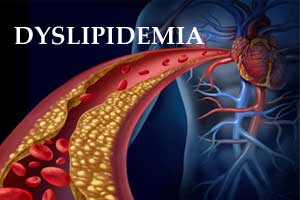- Home
- Editorial
- News
- Practice Guidelines
- Anesthesiology Guidelines
- Cancer Guidelines
- Cardiac Sciences Guidelines
- Critical Care Guidelines
- Dentistry Guidelines
- Dermatology Guidelines
- Diabetes and Endo Guidelines
- Diagnostics Guidelines
- ENT Guidelines
- Featured Practice Guidelines
- Gastroenterology Guidelines
- Geriatrics Guidelines
- Medicine Guidelines
- Nephrology Guidelines
- Neurosciences Guidelines
- Obs and Gynae Guidelines
- Ophthalmology Guidelines
- Orthopaedics Guidelines
- Paediatrics Guidelines
- Psychiatry Guidelines
- Pulmonology Guidelines
- Radiology Guidelines
- Surgery Guidelines
- Urology Guidelines
Management of dyslipidaemias: 2019 ESC/EAS Guidelines

European Society of Cardiology (ESC) and European Atherosclerosis Society (EAS) released updates to their 2016 guidelines for the management of dyslipidemia. The guidelines propose new patient management recommendations and more aggressive proposed goals for low-density lipoprotein cholesterol (LDL-C) levels in addition to revised cardiovascular (CV) risk stratification in high to very high-risk patients. The guidelines have appeared in the European Heart Journal.
Main recommendations are-
LDL Targets-
- Use an LDL-C reduction of at least 50% from baseline and an LDL-C goal of below 1.4 mmol/L (<55 mg/dL) in very-high-risk patients (10-year risk of CV death ≥10%):
- An LDL-C goal of below 1.0 mmol/L (<40 mg/dL) may be considered after a second vascular event within 2 years (not necessarily of the same type as the first event) in high-risk patients on maximally tolerated statin therapy.
- Try to achieve an LDL-C reduction of at least 50% from baseline and an LDL-C goal of below 1.8 mmol/L (<70 mg/dL)for individuals at moderate risk (10-year risk of 5% to <10%).
- An LDL-C goal of below 2.6 mmol/L (<100 mg/dL) may be considered for individuals at moderate risk (10-year risk for CV death of 1% to <5%).
- An LDL-C goal of below 3.0 mmol/L (<116 mg/dL) may be considered for individuals at low risk (10-year risk for CV death <1%)
Cardiovascular imaging for assessment of ASCVD risk
Assessment of carotid and/or femoral arterial plaque burden on arterial ultrasonography as a risk modifier in individuals at low or moderate risk should be considered.In addition to this coronary artery calcium (CAC) score assessment with computed tomography (CT) as a risk modifier in the CV risk assessment of asymptomatic individuals at low or moderate risk may also be considered.
Lipid analyses for risk estimation of Cardiovascular Disease
- Lipoprotein(a) (Lp(a)) may be measured at least once in each adult’s lifetime to identify those with very high inherited Lp(a) levels above 180 mg/dL (>430 nmol/L) who may have a lifetime risk of atherosclerotic CV disease (ASCVD) that is equivalent to the risk associated with heterozygous familial hypercholesterolemia (FH).
Pharmacotherapy recommendations in hypertriglyceridemia –
- Consider the combination of n-3 polyunsaturated fatty acids (PUFAs) (icosapent ethyl 2 × 2g/day) with statins In high-risk (or above) patients with triglyceride (TG) levels between 1.5 and 5.6 mmol/L (135-499 mg/dL) despite statin treatment
In Elderly-
- In elderly aged up to 75 years, statin therapy is recommended for primary prevention based on the level of risk.For primary prevention in older people older than 75 years, initiation of statin treatment may be considered if they are at high risk or above.
In Diabetes patients-
- In patients with type 2 diabetes mellitus (T2DM) at very-high risk, an LDL-C reduction of at least 50% from baseline and an LDL-C goal of below 1.4 mmol/L (<55mg/dL) is recommended.
- Statin therapy is not recommended in premenopausal diabetic patients who are considering pregnancy or who are not using adequate contraception.
- In patients with T2DM at high risk, an LDL-C reduction of at least 50% from baseline and an LDL-C goal of below 1.8 mmol/L (<70 mg/dL) is recommended.
- In patients with T1DM who are at high or very-high risk, statins are recommended.Intensification of statin therapy should be considered before introducing combination therapy. If the goal is not reached, consider a statin combined with ezetimibe.
In patients with ACS
In patients who present with an acute coronary syndrome (ACS), and whose LDL-C levels are not at goal despite already taking a maximally tolerated statin dose and ezetimibe, addition of a proprotein convertase subtilisin/kexin type 9 (PCSK9) inhibitor early after the event (if possible, during hospitalization for the ACS event) should be considered.
In patients with heterozygous FH
In individuals with FH at very-high risk, an LDL-C reduction of over 50% from baseline and an LDL-C goal below 1.4 mmol/L (<55 mg/dL) for primary prevention should be considered.
For further reference log on to :
https://doi.org/10.1093/eurheartj/ehz455

Disclaimer: This site is primarily intended for healthcare professionals. Any content/information on this website does not replace the advice of medical and/or health professionals and should not be construed as medical/diagnostic advice/endorsement or prescription. Use of this site is subject to our terms of use, privacy policy, advertisement policy. © 2020 Minerva Medical Treatment Pvt Ltd